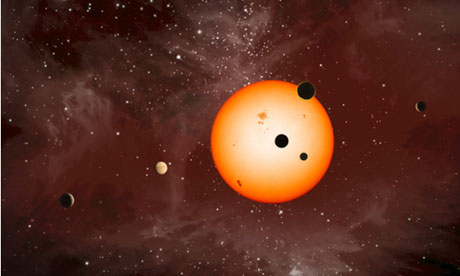 Decades ago, a few astronomers began to suspect that the universe was swarming with some mysterious, invisible substance that was yanking galaxies around with its own powerful gravity. And for those same decades, most of those astronomers' colleagues dismissed the notion as pretty much nuts.
Decades ago, a few astronomers began to suspect that the universe was swarming with some mysterious, invisible substance that was yanking galaxies around with its own powerful gravity. And for those same decades, most of those astronomers' colleagues dismissed the notion as pretty much nuts.
But the evidence kept mounting, and nowadays dark matter is a firmly established concept in modern astrophysics. It pretty much has to exist, in fact, to explain why individual galaxies spin as fast as they do without flying apart, and why groups of galaxies move the way they do in relation to one another.
Dark Matter, Bright Stars: New Evidence on How Galaxies Are Born
Scientists build the world's first anti-laser
 Physicists have built the world's first device that can cancel out a laser beam - a so-called anti-laser. The device, created by a team from Yale University, is capable of absorbing an incoming laser beam entirely.
Physicists have built the world's first device that can cancel out a laser beam - a so-called anti-laser. The device, created by a team from Yale University, is capable of absorbing an incoming laser beam entirely.
But this is not intended as a defence against high-power laser weapons, the researchers said. Instead they think it could be used in next-generation supercomputers which will be built with components that use light rather than electrons.
NASA Images the Entire Sun, Far Side and All
 It might not seem obvious why anyone should care what's happening on the other side of the Sun. But NASA can explain: our home star is a seething, roiling ball of superhot gas that goes through cycles of relative quiet, punctuated by violent outbursts. Every so often, the Sun spits out a blob of charged subatomic particles — and occasionally, one of them is aimed directly at the Earth.
It might not seem obvious why anyone should care what's happening on the other side of the Sun. But NASA can explain: our home star is a seething, roiling ball of superhot gas that goes through cycles of relative quiet, punctuated by violent outbursts. Every so often, the Sun spits out a blob of charged subatomic particles — and occasionally, one of them is aimed directly at the Earth.
These eruptions, known as coronal mass ejections, aren't enough to hurt the planet physically; they're very hot, but also very insubstantial. What they can do is fry the electronics of communications satellites, and even put astronauts in danger of a radiation overdose.
Nasa scientists discover planetary system
 Astronomers have discovered a planetary system made up of six planets orbiting a Sun-like star that is more than 2,000 light years from Earth. It is the largest number of planets found so far around a single star. More than 100 planets have been seen outside our solar system, but most are Jupiter-like gas giants, and almost all are in single-planet systems.
Astronomers have discovered a planetary system made up of six planets orbiting a Sun-like star that is more than 2,000 light years from Earth. It is the largest number of planets found so far around a single star. More than 100 planets have been seen outside our solar system, but most are Jupiter-like gas giants, and almost all are in single-planet systems.
Jack Lissauer, a scientist at Nasa's Ames research centre in California and a lead author on a paper published tomorrow in the journal Nature, said that the Kepler-11 finding was "the biggest thing in exoplanets since the discovery of 51 Pegasi B, the first exoplanet, back in 1995".
Gazing Afar for Other Earths, and Other Beings
 In a building at NASA’s Ames Research Center here, computers are sifting and resifting the light from 156,000 stars, seeking to find in the flickering of distant suns the first hints that humanity is not alone in the universe. The stars are being monitored by a $600 million satellite observatory named Kepler, whose job is to conduct a kind of Gallup poll of worlds in the cosmos.
In a building at NASA’s Ames Research Center here, computers are sifting and resifting the light from 156,000 stars, seeking to find in the flickering of distant suns the first hints that humanity is not alone in the universe. The stars are being monitored by a $600 million satellite observatory named Kepler, whose job is to conduct a kind of Gallup poll of worlds in the cosmos.
On Wednesday, Kepler’s astronomers are scheduled to unveil a closely kept list of 400 stars that are their brightest and best bets so far for harboring planets, some of which could turn out to be the smallest and most Earth-like worlds discovered out there to date. They represent the first glimpse of riches to come in a quest that is as old as the imagination and as new as the iPad.
Research: Early modern humans left Africa earlier than thought
 The discovery of an ancient stone tool kit in the United Arab Emirates, reported in today's edition of the journal Science, now is raising the possibility that today's modern humans first started leaving Africa earlier than paleontologists previously thought.
The discovery of an ancient stone tool kit in the United Arab Emirates, reported in today's edition of the journal Science, now is raising the possibility that today's modern humans first started leaving Africa earlier than paleontologists previously thought.
The question of when modern humans first started leaving the African continent has been debated since the 1980s. African fossils of modern-looking humans date to about 200,000 years ago, but gene studies of non-Africans suggest that people only left the mother continent by 60,000 years ago.
Hubble telescope detects the oldest known galaxy
 The Hubble Space Telescope has detected what scientists believe may be the oldest galaxy ever observed. It is thought the galaxy is more than 13 billion years old and existed 480 million years after the Big Bang.
The Hubble Space Telescope has detected what scientists believe may be the oldest galaxy ever observed. It is thought the galaxy is more than 13 billion years old and existed 480 million years after the Big Bang.
A Nasa team says this was a period when galaxy formation in the early Universe was going into "overdrive". The image, which has been published in Nature journal, was detected using Hubble's recently installed wide field camera.
More Articles...
Page 42 of 61

 Science Glance
Science Glance






























